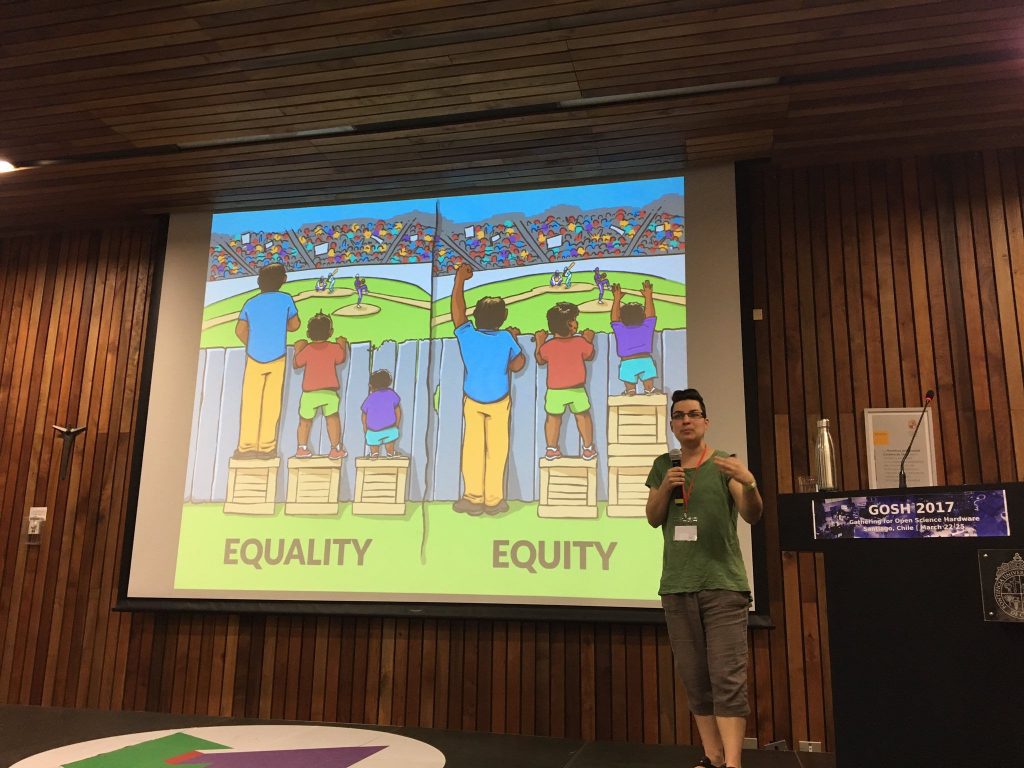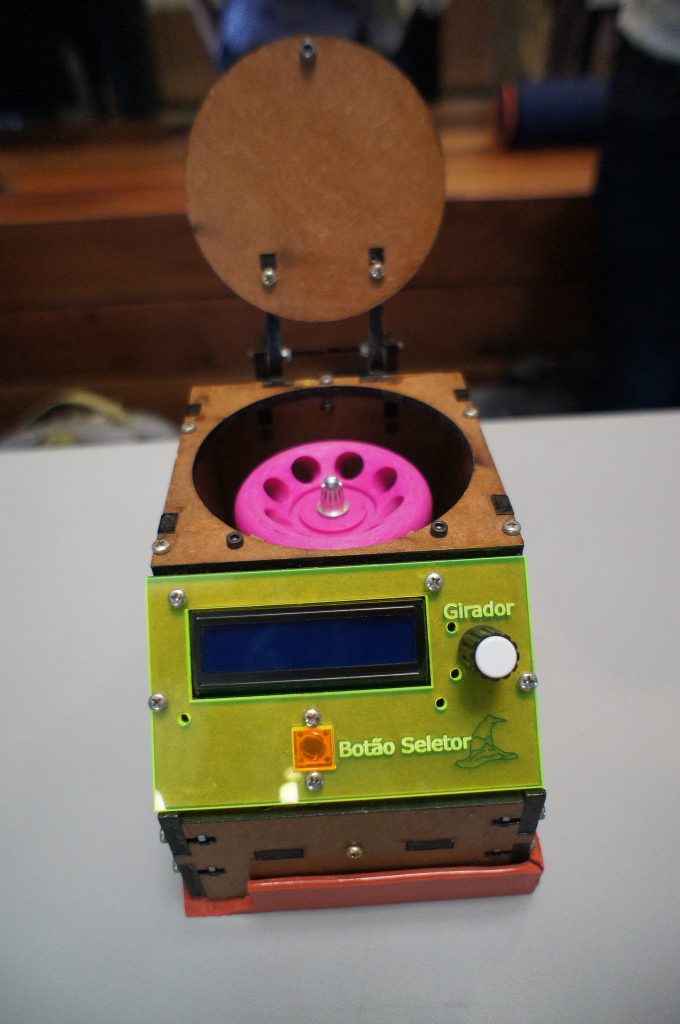Gathering for Open Science Hardware 2017: Building a Movement
 Without hardware, there is no science. Instruments, reagents, computers, and lab equipment are the platforms for producing systematic knowledge. Innovations from lenses to atomic force microscopes to DNA sequencers to particle accelerators have opened up new fields of knowledge with huge potential impacts for science and society. However, participants in the Gathering for Open Science Hardware, currently taking place at the Innovation Centre, Pontificia Universidad Católica de Chile, argue that limited access to scientific tools impedes the progress and reach of science. Black-box scientific tools block creativity and customization through high mark-ups and proprietary designs, compounded by intellectual property restrictions. Open Science Hardware addresses part of this problem by sharing designs, instructions for building, and protocols openly, for anyone to reuse.
Without hardware, there is no science. Instruments, reagents, computers, and lab equipment are the platforms for producing systematic knowledge. Innovations from lenses to atomic force microscopes to DNA sequencers to particle accelerators have opened up new fields of knowledge with huge potential impacts for science and society. However, participants in the Gathering for Open Science Hardware, currently taking place at the Innovation Centre, Pontificia Universidad Católica de Chile, argue that limited access to scientific tools impedes the progress and reach of science. Black-box scientific tools block creativity and customization through high mark-ups and proprietary designs, compounded by intellectual property restrictions. Open Science Hardware addresses part of this problem by sharing designs, instructions for building, and protocols openly, for anyone to reuse.
The open science hardware movement
There is a growing movement for open science hardware with successful projects, communities and companies setting up across the world that increase access to many groups of people. Sensors for environmental monitoring developed by Public Lab combine DIY sensing and citizen science within a broader theme of environmental justice, enabling communities affected by industrial pollution to gather data and evidence to try to effect change that improves their lives and situation. In a concrete example, their aerial mapping work broadened access to knowledge as well as involvement in evidence collection during the Deep Horizon disaster. The deep sea exploration vehicle OpenROV bridges community and academia; the project stemmed from academic frustration with lack of research equipment funding but led to a range of projects making oceanography available for everyone: from communities in Papua New Guinea to US high school students. Working with communities requires a strong and intentional approach to equity and ethics.
At institutions such as the European Organization for Nuclear Research (CERN) in Geneva, engineers wanted a way to share open designs to increase the reach of their technology and its benefits to society, but also pragmatically to avoid vendor lock-in. This led to creation of the CERN Open Hardware License to help share designs which are explicitly and legally open, an open hardware repository and successful hardware collaborations such as the White Rabbit timing control system that now involve many international collaborators. Max Liboiron directs the Civic Laboratory for Environmental Action Research (CLEAR), a feminist marine science and technology laboratory that specializes in citizen science and grassroots environmental monitoring of plastic pollution. Her talk at GOSH 2017 emphasised the need to consider equity in working with communities and the failure of ‘universal’ scientific protocols to consider local factors, for example the de facto mechanism for measuring microplastic pollution by sifting sand is impossible in the frozen north of Canada. Cost and language are significant barriers to engagement of local and indigenous people so CLEAR’s work keeps equity as a guiding principle of all their technology development and deployment.
Education is also a key theme in the GOSH community. Backyard Brains aim to use open hardware to teach neuroscience while Karkhana is designing learning experiences for future innovators in Nepal, and Open Science School is making interdisciplinary collaboration workshops to open research in life sciences. Projects like Centro de Tecnologia Acadêmica in Brazil develop tools for research, and Teaching and Research in Natural Sciences for Development (TReND) has organized numerous workshops and extended teaching courses on making open labware, including a course in Addis Ababa in 2015 and an upcoming 2017 course in Ibadan, Nigeria.
 Open science hardware is not used only in institutions and organisations: grassroots networks and collectives play a major role in bridging disciplines and convening creative interactions around science, art and design. The Hackteria global network has published open designs for microscopes and lab equipment since 2009 and runs workshops around the world from Tokyo to Yogyakarta to Nairobi combining bio-art, traditional biotechnologies such as fermentation and DIYbio. Interspecifics.cc from Mexico are an art collective who experiment in the intersection of art and science, for example in the use of sound to understand the bioelectrical activity of different bacterial consortiums, plants, slime molds and humans using DIY and custom-made sets of hardware.
Open science hardware is not used only in institutions and organisations: grassroots networks and collectives play a major role in bridging disciplines and convening creative interactions around science, art and design. The Hackteria global network has published open designs for microscopes and lab equipment since 2009 and runs workshops around the world from Tokyo to Yogyakarta to Nairobi combining bio-art, traditional biotechnologies such as fermentation and DIYbio. Interspecifics.cc from Mexico are an art collective who experiment in the intersection of art and science, for example in the use of sound to understand the bioelectrical activity of different bacterial consortiums, plants, slime molds and humans using DIY and custom-made sets of hardware.
GOSH 2017 aimed to represent as many points as possible across the multidimensional open science hardware space and the organisations mentioned above are just a few examples of a growing and evolving set of communities.
From a manifesto to a roadmap
GOSH 2016 was held at CERN in Geneva and brought together community convenors for the first international and interdisciplinary conference focused on Open Science Hardware. The most important feature of the meeting was the passion for change and shared values of the diverse group of participants. Those values were articulated in the GOSH Manifesto, which has since been signed by over 240 signatories and translated into six languages. Online tools like the GOSH forum or the Journal of Open Hardware arose after the conference to help connect this international movement.
The global dimension of GOSH allowed exchange and comparison of many different contexts where open science hardware is used or produced. For example, local laws and regulations allow particular types of legal licensing to be applied to hardware in Brazil but not elsewhere; US regulations allow genetic modification experiments outside of academic contexts but other countries do not. Avoiding one size fits all solutions implies engaging local communities, to allow a diversity of actions and approaches. With this in mind, GOSH 2017 moved out of the US and Europe to Chile and made efforts to form local connections and raise the profile of open technologies for science in the region, including drawing over a third of participants from Latin America and arranging visits to local projects and makerspaces.
 The goal of GOSH 2017 is to bring the spirit of the GOSH Manifesto to life. The conference started by a series of keynotes from all around the world where participants showed their own case studies of open science hardware. An open poster and booth session held on the first day of the conference invited high school students, undergraduates and the general public to see hardware demonstrations and engage with the attendees. Unconference style discussion groups covered different topics such as: scaling up open hardware production, standards for safety and quality, the impact of open science hardware in developing countries, inclusivity and diversity, the embedded politics of scientific tools, and interactions between art and science. The participants have focused on sharing experiences as users and developers of open science hardware, identifying best practices, collaborating to create opportunities and address failures, and building lasting friendships and connections across the world.
The goal of GOSH 2017 is to bring the spirit of the GOSH Manifesto to life. The conference started by a series of keynotes from all around the world where participants showed their own case studies of open science hardware. An open poster and booth session held on the first day of the conference invited high school students, undergraduates and the general public to see hardware demonstrations and engage with the attendees. Unconference style discussion groups covered different topics such as: scaling up open hardware production, standards for safety and quality, the impact of open science hardware in developing countries, inclusivity and diversity, the embedded politics of scientific tools, and interactions between art and science. The participants have focused on sharing experiences as users and developers of open science hardware, identifying best practices, collaborating to create opportunities and address failures, and building lasting friendships and connections across the world.
The sessions were not focused only on the technical aspects of open science hardware, but rather making an effort in finding common values and critical actions to establish open science hardware as ubiquitous by 2025. Key steps in the advancement of open science hardware includes support from organizations or public institutions, but also glueing together a strong grassroots community, which requires buy-in and support from many different groups of people. GOSH 2017 will culminate in collaboratively drafting and publishing a roadmap for open science hardware. Using the roadmap, we intend to: change the norms within established, institutional science so researchers openly share knowledge and technology; so research can happen in or out of the academy, in or out of the lab, in or out of commercial spaces; and so enable science to take place where it would not usually happen.
The Gathering for Open Science Hardware (GOSH) would like to thank the Alfred P. Sloan Foundation for its ongoing support.
Interested in open source hardware? Check out the Open Source Toolkit: channels.plos.org/open-source-toolkit
All photos are Public Domain and taken from the GOSH Community Flickr Account
var addthis_config = {"data_track_clickback":true,"ui_atversion":300,"ignore_server_config":true}; var addthis_share = {};| Gathering for Open Science Hardware 2017: building a movement was written collaboratively by Andre Maia Chagas, Max Liboiron, Jenny Molloy, Juan Manuel Garcia Arcos and Jeffrey Warren and published in PLOS. It is being republished in Open Health News under the terms of the Creative Commons Attribution 4.0 International (CC BY 4.0). The original copy of this article can be found here. |
- Tags:
- Addis Ababa
- Andre Maia Chagas
- Backyard Brains
- bioelectrical activity
- Centro de Tecnologia Acadêmica in Brazil
- CERN Open Hardware License
- citizen science
- Civic Laboratory for Environmental Action Research (CLEAR)
- Deep Horizon
- DIY sensing
- DIYbio
- European Organization for Nuclear Research (CERN)
- Gathering for Open Science Hardware (GOSH)
- GOSH community
- GOSH Manifesto
- Hackteria global network
- hardware collaborations
- Innovation
- Innovation Centre
- Interspecifics.cc
- Jeffrey Warren
- Jenny Molloy
- Juan Manuel Garcia Arcos
- Karkhana
- Max Liboiron
- open designs
- open hardware repository
- open research in life sciences
- open science hardware movement
- Open Science School
- open technologies for science
- OpenROV
- Pontificia Universidad Católica de Chile
- Public Lab
- Teaching and Research in Natural Sciences for Development (TReND)
- White Rabbit timing control system
- Login to post comments